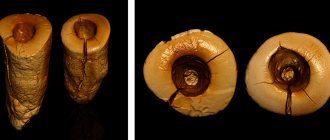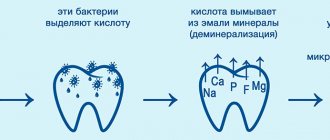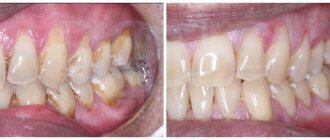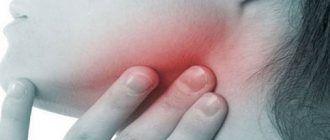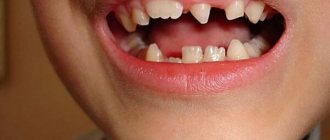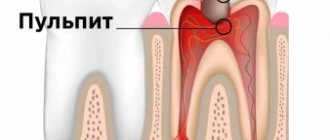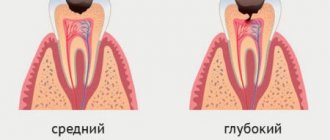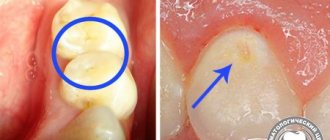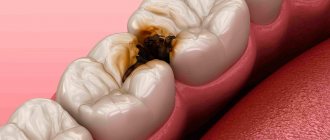Author of the article:
Soldatova Lyudmila Nikolaevna
Candidate of Medical Sciences, Professor of the Department of Clinical Dentistry of the St. Petersburg Medical and Social Institute, Chief Physician of the Alfa-Dent Dental Clinic, St. Petersburg
Medium caries is a stage of the carious process that occurs after the initial one and precedes the deep one. It is characterized not only by the destruction of enamel, but also by disruption of the dentin structure. Often the disease is practically asymptomatic, so the patient cannot independently identify the presence of this disease. The only method of self-diagnosis is to pay attention to changes in the appearance of the tooth when examining the oral cavity in a mirror (presence of holes) or to the appearance of sensitivity while eating.
If you look at a photo of average caries, you will notice pronounced changes in the structure and color of the affected area. Most often, the disease develops on the contact (chewing) part of the tooth. In the photo you can see dark brown or almost black spots, small or large holes, which can be located on any part of the tooth. These holes are a carious cavity in which dentin gradually softens and food debris accumulates.
With chronic average caries, the destruction of the enamel and dentinal layer occurs faster - carious cavities can appear as early as five months after the initial changes in the tooth enamel. Most often, young children suffer from the chronic form of the disease.
Causes of the disease
There are several factors that lead to the occurrence of this disease:
- Cariogenic microflora of the oral cavity.
- Increased carbohydrate content in the diet.
- Reduced resistance of hard tissues.
- Lack of oral hygiene.
- Malocclusion.
- Genetic predisposition to the disease.
- Plaque or tartar.
- Weakening of the immune system.
- Bleeding gums.
- Changes in the composition of saliva.
- Lack of calcium.
- Fluoride deficiency.
- Poor diet.
- Lack of vitamins.
- Abuse of carbonated drinks.
The main cause of average caries is late diagnosis of the disease at an early stage.
Isolated dentin caries: what are its features
Sometimes lesions and extensive carious cavities form in the dentin of a permanent tooth while maintaining the integrity of the enamel. This is how isolated, atypical caries develops. Its difference from the classical form is that the carious lesion does not affect the enamel, but immediately passes to the dentin.
This happens, for example, in cases where a person uses fluoride preparations for a long time for preventive purposes. This leads to strengthening of the enamel located on top of the affected dentin, and, as it were, “seals” the pathological process inside the tooth.
Symptoms of the disease
The disease can exclusively affect the upper layers of dentin. The process of development of medium-sized caries is accompanied by destruction of the enamel layer and a violation of the boundary between enamel and dentin. As a result, patients complain of the following unpleasant sensations:
- The presence of a carious cavity, which is easily detected using the tongue. In some cases, it may have sharp edges and cause injury.
- Food getting into the carious hole if it is located on the contact part of the tooth.
- Short-term painful sensations from exposure to hot or cold food, liquids, from the chewing process and from mechanical impact on the diseased tooth. Once the cause of the pain is eliminated, the unpleasant symptoms quickly disappear.
Tooth structure and types of carious lesions
A tooth consists of several parts. On top it is covered with hard mineralized enamel, underneath there is dentin, and even deeper - the root of the tooth and pulp. Caries is a pathological process that is accompanied by demineralization and softening of hard dental tissues with the subsequent formation of a carious cavity. The process can affect any part of the tooth; depending on this, caries of enamel, dentin or cement is distinguished.
Carious lesions of the enamel are characterized by symptoms such as softening, the appearance of a white or brown spot, roughness, and sometimes the carious cavity is located in the enamel. If the lesion affects the bone tissue of the tooth, which makes up its bulk, in this case we speak of dentin caries. This form of lesion is characterized by the formation of a carious cavity directly in the dentin.
Cement caries affects the root of the tooth and contributes to its exposure. It often occurs with gum disease, when there is no close contact between the tooth and the gum.
Diagnosis of the disease
To prescribe effective treatment for the disease and exclude the presence of other diseases, it is necessary to diagnose secondary caries, which is carried out by the treating dentist.
In most cases, an experienced specialist only needs an instrumental examination to make a diagnosis. It is carried out using a probe and a mirror. As a result of the examination, a carious cavity is discovered, inside of which there is softened dentin. Mild pain is present only when probing the bottom of the cavity, since there are exposed nerve endings there. The walls of the carious cavity are insensitive.
During diagnosis, the doctor pays attention to the following factors:
- Density of the cavity bottom.
- Localization of the carious hole.
- The color of the damaged tooth.
- The presence and nature of pain in the patient during the study.
A soft bottom indicates moderate dental caries, and its density may indicate the presence of a wedge-shaped defect. The tooth becomes gray if the patient has developed chronic periodontitis. The short duration of painful sensations indicates superficial caries, and if the pain lasts longer than ten seconds, the disease has acquired a deep form.
If the affected area is in a hard-to-reach place, the doctor may prescribe an X-ray examination for the patient. In some cases, the dentist recommends undergoing electroodontic diagnostics or thermal testing.
How does a tooth hurt with dentin caries?
Different types of pain are characteristic of different stages of caries. When dentin is damaged, the stages of medium and deep caries are distinguished. In the first case, the carious cavity is located closer to the enamel; in the deep stage, it is as close as possible to the area of the dental nerves.
The middle stage of dentin caries is characterized by a painful reaction in response to temperature or taste stimuli, the pain quickly passes, and the intervals without pain are quite long.
If caries is in the stage of deep damage to dentin, it is characterized by intense long-term pain with short intervals without pain.
Deep caries is the most dangerous, because at any moment it can be complicated by pulpitis, periodontitis, purulent inflammation, and the spread of infection beyond the dental tissues. But even the moderate one can turn into the deep stage at any moment, so if you have a toothache of any nature, you should consult a dentist as soon as possible.
Treatment of average caries
After diagnosis, it is necessary to urgently treat the disease to prevent the process from spreading to the deep layers of dentin. Otherwise, inflammation of the pulp may occur.
Treatment is carried out by preparing the damaged areas. It goes through several stages:
- The overhanging edges of the carious hole are carefully removed.
- Dentin, which has undergone a process of softening and pigmentation, is removed from the cavity.
- The bottom and walls of the damaged tooth are cleaned of the remains of destroyed tissue.
- A cavity is formed for subsequent filling.
During each stage, the dentist uses a specific type of bur, which differs in the shape and diameter of the tip. Preparation is carried out in bright light. At the end of this process, the cleaned cavity is treated with antiseptics, degreased, and then thoroughly dried.
The walls and bottom of the hole are coated with a special “glue”, and then the cavity is filled with filling material, which undergoes a curing process using chemical or light radiation.
The finished filling is corrected using diamond burs, as well as using various grinding discs, pastes and brushes. Correction can be made several times. The purpose of this procedure is to achieve maximum comfort in the patient when clenching the jaw. The restored surface should not cause even the slightest discomfort.
The effectiveness of non-invasive treatment methods
If the damage caused to the tooth is insignificant, and the enamel is sufficiently dense, treatment of enamel caries in the white spot stage can be carried out without preparation and filling. In this case, the affected area is ground and polished, which avoids the recurrence of the disease. After this, the tooth is locally fluoridated, and the process of restoring the enamel from the inside begins. This treatment method is called remineralization. Fluoridation can also be done at home - using special preparations - but only after consulting a doctor.
Also, modern methods of non-invasive treatment of enamel caries include: chemical-mechanical treatment (infiltration), air-abrasive treatment and ozone treatment. All these methods allow you to do without a drill and carry out treatment with virtually no discomfort for the patient. At the same time, it is possible to preserve healthy tooth tissue to the maximum - the microhardness of the enamel is damaged during enamel caries, and all of the above methods allow you to act only on softened tissue, without affecting the healthy parts of the tooth.
Regardless of the chosen technique, in order for the treatment of dental caries to be effective and the disease not to recur, the participation of the patient himself is important. Only a conscientious approach to hygiene will help maintain oral health.
Prognosis and consequences of the disease
Treatment of this disease, if the dentist has sufficient experience, is successful - all unpleasant sensations in the sealed cavity completely disappear, and the tooth again acquires aesthetic appeal. If an untreated area remains under the filling, the disease will progress further. For this reason, it is necessary to carefully consider the choice of clinic and attending physician.
If average caries is not treated in a timely manner, the disease will enter an advanced stage, which is fraught with severe pain, the development of pulpitis and periodontitis, and then tooth loss.
Why is it better to treat caries at the Medikastom dental clinic?
- Many years of experience. The dental clinic has been operating since 2000, successfully providing care to patients even with complex illnesses.
- Highly qualified staff who treat each patient with care and sensitivity.
- First-class equipment and modern drugs.
- Using the latest developments and treatment methods.
- Affordable cost of caries treatment.
- Maximum comfortable conditions for the patient.
- Caries treatment 24/7. Our clinic works for you around the clock, without holidays and weekends, providing qualified assistance when it is most needed.
You can get detailed information on caries treatment by calling us at +7(499) 283-71-58.
Call and sign up for a free consultation right now!
We are waiting for you!
Disease prevention
After each meal, food particles remain in the oral cavity, which contribute to the development of decay processes and create a favorable environment for bacteria. To prevent the spread of harmful microorganisms, it is necessary to brush your teeth regularly.
If a person has a tendency to develop the disease, the dentist prescribes special toothpastes that can reduce the risk of the disease. Thus, we recommend ASEPTA PLUS REMINERALIZATION paste, which strengthens the enamel and prevents caries on teeth.
Prevention of dentine caries in permanent and baby teeth
Measures to prevent dentin caries are similar to the prevention of caries in other parts of the tooth.
These include:
- Proper nutrition with a minimum amount of sugars and fast carbohydrates, rich in fluoride, calcium, phosphorus. Avoiding frequent snacking.
- Thorough daily brushing of teeth twice a day using a toothbrush, paste, and floss. The additional use of an irrigator to clean hard-to-reach places and interdental spaces, as well as mouth rinses, helps reduce the risk of caries.
- Schedule a visit to the dentist twice a year, as well as immediately contact a doctor at the first sign of caries.
- Professional teeth cleaning using special equipment twice a year.
- If necessary and as prescribed by a doctor, use vitamin-mineral complexes, which contain components beneficial for dental health.
- Drinking fluoridated drinking water, which is enriched with minerals.
Compliance with these preventive measures allows you to maintain the health and beauty of your teeth and reduces the risk of developing caries and other dental diseases.
Clinical researches
Clinical studies have proven that regular use of professional toothpaste ASEPTA REMINERALIZATION improved the condition of the enamel by 64% and reduced tooth sensitivity by 66% after just 4 weeks.
Sources:
- Report on the determination/confirmation of the preventive properties of personal oral hygiene products “ASEPTA PLUS” Remineralization doctor-researcher A.A. Leontyev, head Department of Preventive Dentistry, Doctor of Medical Sciences, Professor S.B. Ulitovsky First St. Petersburg State Medical University named after. acad. I.P. Pavlova, Department of Preventive Dentistry
- Clinical experience in using the Asepta series of products Fuchs Elena Ivanovna Assistant of the Department of Therapeutic and Pediatric Dentistry State Budgetary Educational Institution of Higher Professional Education Ryazan State Medical University named after Academician I.P. Pavlova of the Ministry of Health and Social Development of the Russian Federation (GBOU VPO RyazSMU Ministry of Health and Social Development of Russia)
- Evaluation of the clinical effectiveness of a combined drug of local etiotropic action in the treatment of inflammatory periodontal diseases (E.L. Kalichkina, E.A. Tyo, Z.Z. Abubakarova) E.L. Kalichkina, candidate of medical sciences, assistant of the department of therapeutic dentistry, Kemerovo State Medical Academy of Roszdrav, Kemerovo E.A. Tyo, MD, professor, head of the department of therapeutic dentistry, Kemerovo State Medical Academy of Roszdrav, Kemerovo Abubakarova, assistant of the department of therapeutic dentistry, Kemerovo State Medical Academy of Roszdrav, Kemerovo GOU HPE Kemerovo State Medical Academy of Roszdrav , Kemerovo
Technologies and materials
To diagnose and treat caries, the PROFI-Dent clinic uses a wide range of advanced methods and materials:
- digital pantomograph and radiovisiograph;
- safe, effective anesthetics of the latest generation;
- advanced dental units;
- modern surgical equipment (physiodispenser, ultrasound and laser devices);
- durable filling materials with high abrasion resistance (light-curing);
- inlays, veneers, etc.;
- modern calcium- and fluorine-containing preparations for remineralizing therapy;
- the latest restoration techniques.
The use of advanced diagnostic equipment and the latest materials ensures impeccable results. Our dentistry provides turnkey caries treatment, which includes not only the elimination of inflammation and pain, but also the complete aesthetic restoration of the tooth’s shape using light-transmitting materials.
